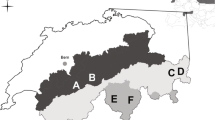Summary
In this study we tested the hypothesis that the European hareLepus europeaeus avoids areas around nests of the ravenCorvus corax built on electricity pylons in an intensively used farmland. Hare counts were conducted in spring 1999 and 2000 in areas of 1000 m length and 200 m width along 47 transect lines starting from pylons with raven nests. Likewise, 47 control areas along transect lines, which started from pylons without any nests were studied. The two types of transects did not differ with respect to the number of recorded hares. The main factor influencing hare occurrence in farmland was found to be habitat diversity.
Zusammenfassung
Geprüft wurde, ob Feldhasen in intensiv landwirtschaftlich genutzten Gebieten die Umgebung von Kolkrabennestern meiden. Dazu wurden im Frühjahr 1999 und 2000, ausgehend von Strommasten mit Rabennestern, auf 47, jeweils 1000 Meter langen und 200 Meter breiten Transektflächen Hasenzählungen durchgeführt. Die ermittelten Werte wurden mit denen von 47 gleich gearteten Kontrolltransekten verglichen, die von Masten ohne Rabennest ausgingen. Die Anzahl der entdeckten Hasen unterschied sich nicht signifikant zwischen den beiden Transekttypen. Entscheidend für die Verteilung der Hasen in der Agrarlandschaft war die Habitatdiversität.
Résumé
Dans cette étude a été testée l'hypothèse suivant laquelle, dans une exploitation agricole intensive, le Lièvre d'Europe évite le voisinage de nids de Grand Corbeau construits sur des pylones électriques. Des comptages ont été effectués au printemps 1999 et 2000 sur des sites de 1000m de longueur et de 200m de large le long de 47 transects au départ de pylones où se trouvaient des nids de Grand Corbeau. De façon analogue, 47 sites de contrôle ont été étudiés le long de transects au départ de pylones dépourvus de nids. Les deux types de transects ne différaient pas quant au nombre de lièvres recensés. Le facteur principal influençant l'occurrence de lièvres dans l'espace agricole s'est avéré être la diversité de l'habitat.
Similar content being viewed by others
References
Bednorz, J., 1991: Die Wiederausbreitung des Kolkraben(Corvus corax) in Polen. Metelener Schrift. Naturschutz2: 29–35.
Bednorz, J., 2000: RavensCorvus corax Linnaeus, 1758, nesting on electricity pylons in the Wielkopolska region. Acta zool. cracov.43: 177–184.
Boonstra, R., Hik, D., Singleton, G. R., Tinnikov, A. 1998: The impact of predator-induced stress on the snowshoe hare cycle. Ecol. Monogr.68: 371–394.
Goszczyński, J., Ryszkowski, L., Truszkowski, J. 1976. The role of the European hare in the diet of predators in cultivated field systems. In: Ecology and management of European hare populations.Z. Pielowski &Z. Puckek, (eds.). PWRiL, Warszawa: 127–133.
Kauhala, K., Helle, P., Helle, E., Korhonen, J. 1999. Impact of predator removal on mountain hare populations in Finland. Ann. zool. fenn.36: 139–148.
Korpimäki, E., Koivunen, V., Hakkarainen, H. 1996: Microhabitat use and behavior of voles under weasel and raptor predation risk; predation facilitation? Behav. Ecol.7: 30–34.
Lagos, V. O., Contreras, L. C., Meserve, P. L., Gutiérrez, J. R., Jaksic, F. M. 1995: Effects of predation risk on space use by small mammals: a field experiment with a neotropical rodent. Oikos74: 259–264.
Langbein, J., Hutchings, M. R., Harris, S., Stoate, C., Tapper, S. C., Wray, S. 1999: Techniques for assessing the abundance of brown haresLepus europaeus. Mammal Rev.29: 93–116.
Lewandowski, K., Nowakowski, J. J. 1993: Spatial distribution of brown hareLepus europaeus populations in habitats of various types of agriculture. Acta theriol.38: 435–442.
Lorek, G. 1992: Behaviour of birds of prey and carrion feeders on railways. Notatki Ornitologiczne33: 101–109.
Ludwig, J. A., Reynolds, J. F. 1988: Statistical ecology. New York: John Wiley & Sons.
Magurie, A. J. 2000: Whimbrel attacked by a peregrine falcon and killed by a common raven in Northern Carolina. Wilson Bull.112: 429–430.
Mason, C. F., Macdonald, S. M. 1995: Corvids feeding on carrion. Bird Study42: 255–256.
Norrdahl, K., Korpimäki, E. 1998: Fear in farmland: how much does predator avoidance affect bird community structure? J. Avian Biol.29: 79–85.
Otto, R. D. 1998: Attempted predation on a snowshoe hare,Lepus americanus, by an American marten,Martes americana, and a northern raven,Corvus corax. Can. Field Nat.112: 333–334.
Panek, M., Kamieniarz, R. 1999: Relationships between density of brown hareLepus europaeus and landscape structure in Poland in the years 1981–1995. Acta theriol.44: 67–75.
Petersen, B. S. 1996: The distribution of birds in Danish farmland. Pesticides Res.17: 1–72.
Pielowski, Z. 1976: Cats and dogs in the European hare hunting ground. In: Ecology and management of European hare populations.Z. Pielowski &Z. Pucek, (eds.), PWRiL, Warszawa: 153–156.
Ratcliffe, D. 1997: The Raven. T & D Poyser, London.
Spittler, H. 1987: Zur Ursache des sprunghaften Streckenrückganges beim Feldhasen (Lepus europaeus Pallas 1778) in den Jahren 1978 und 1979. Z. Jagdwiss.33: 175–184.
Travaini, A., Donazar, J. A., Rodriguez, A., Ceballos, O., Funes, M., Delibes, M., Hiraldo, F. 1998: Use of European hare (Lepus europaeus) carcasses by an avian scavenging assemblage in Patagonia. J. Zool.246: 175–181.
Tryjanowski, P. 1999: Effect of habitat diversity on breeding birds: comparison of farmland bird community in the region of Wielkopolska (W. Poland) with relevant data from other European studies. Pol. J. Ecol.47: 153–174.
Zawadzka, D. 1996: Distribution, habitat selection, food and reproduction of the raven(Corvus corax) in the National Park of Lake Wigry. Notatki Ornitologiczne37: 225–245.
Author information
Authors and Affiliations
Rights and permissions
About this article
Cite this article
Tryjanowski, P. Does the european hareLepus europaeus avoid ravenCorvus corax nests in farmland?. Zeitschrift für Jagdwissenschaft 47, 63–66 (2001). https://doi.org/10.1007/BF02242414
Issue Date:
DOI: https://doi.org/10.1007/BF02242414




